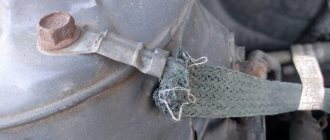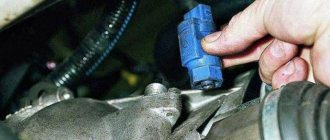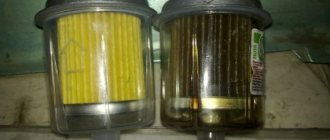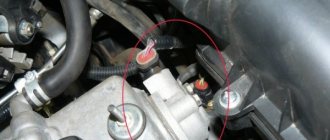Bright shine without polishing: how to make your car shine?
A freshly washed car , coated with wax, shines and sparkles like new, as if you just recently took it from a car dealership. It's a pleasant feeling, isn't it? Even better is that the car not only radiates beauty - its body, or rather paintwork, is also protected from dirt, rain and road reagents. But are there any pitfalls when applying a wax protective layer? We turned to professionals and this is what we learned about how to apply this very wax, what this procedure will give, which wax is better to use and is there a difference between cheap and expensive formulations.
Those who wax their car after washing are doing absolutely the right thing. Thus, they give the paint a beautiful shine and “seal” it, preventing the negative influence of the environment in all its manifestations (rain, ultraviolet radiation, pollen, bird droppings, insects, snow or road salt).
Question #1: How often should I wax my car?
It is recommended to carry out the procedure of applying it to the car at least twice a year. Once in the fall to provide the car with a protective layer from road salt and dirt. And once in the spring - to update the layer.
According to other sources (most likely, they will tell you this at the car wash), it is necessary to update the layer after every fourth or fifth wash.
Both options are working and have a right to exist. We will explain why this is so below.
Question No. 2. How to properly apply wax to the body?
Hot wax
There are several options for applying car wax. For example, hot wax. The essence of the application is as follows:
The car is thoroughly washed, using car shampoo to remove road dirt, gasoline deposits, rubber particles, etc. The cleaner the surface, the better.
Next comes drying the car. There simply shouldn't be any moisture on the body. It is important.
And finally, applying the composition itself: the wax is first diluted in hot water in a certain proportion (you need to carefully monitor the ratio of wax/amount of water and the water temperature if you decide to apply it yourself). The prepared composition is applied with a sponge. At the end of the process, the surface is given shine by polishing.
The product will dry very quickly and will repel water and dirt efficiently and will remain on the surface of the paintwork for a long time.
Cost: from 150 to 400 rubles depending on the volume of container - 250-500 ml market.yandex.ru
Cold wax
Another type of car wax on the market is cold wax. Application is easier, application takes much less time (this is a plus), but the result is less stable (this is a minus) - you will have to renew the protection every couple of washes.
The cold type of wax is applied to the body with a spray (it’s easier), the residue is washed off with water.
Cost: about 250 rubles per liter market.yandex.ru
Hard wax
Those who value long-term protection can try hard wax. The method of application is almost the same as the “hot” version. The only thing is that the protection is applied manually and not diluted in water.
Cost: The most expensive type of wax. A normal polish costs from 800 and above - 1,300-1,600 rubles. market.yandex.ru
Please note that some types of wax are suitable for dark or light cars! According to the pros, you won’t notice any difference if you cover your car with the wrong “shade” of transparent wax. We're just saying this just in case.
Let us repeat once again the most important principles of using wax for cars:
Before applying invisible protection, it is necessary to wash the car, which removes not only dirt, but also the old layer of wax.
The wax itself can be applied with a special glove, non-lint microfiber or sponge. Whether the wax is applied in a cross-shaped motion, that is, first transverse and then longitudinal, or circular, does not matter.
Wait for the wax to dry for a few minutes until a matte coating appears. There is no point in polishing until the solvents evaporate.
A simple visual test shows whether the wax layer has dried: a cloudy, barely noticeable film appears on the surface.
Important: Car wax is generally not harmful to health, but as a precaution, you should wear gloves before handling it. Also open the garage door or wash outdoors (but not in direct sunlight).
Make sure that the compound is not applied to plastic or rubber parts. The same goes for glass, especially the windshield. First of all, it's useless. Secondly, and more importantly, the windshield wiper will not work properly on the wax film until it wears off, making it difficult to see and leaving water droplets on the glass.
Types of liquid wax
In practice, three types are used: cold, hot and foam. The consistency of the cold lipid is liquid, containing cationic surfactants and an emulsion agent. It makes no sense to use it to protect the car body for those car owners who want to use the effect of fat for a long time. You will have to manually apply a new layer each time after washing. However, the opportunity to hide minor scratches and smooth out unevenness with its help is tempting.
Hot wax is a fat-like substance that can be either artificial or natural. Melts at temperatures from 40 to 90 degrees. For drivers who value maintaining their properties for a long time, the application of this composition is ideal, because it is possible to re-coat the car with a layer of such fat even after a year.
In order to apply wax, it is important to mix wax and hot water in certain proportions and then apply this consistency using a napkin to the surface of the car.
Foam wax is similar in composition to hot wax, but differs in that if you don’t have special equipment, you won’t be able to apply it.
To apply liquid foundation, you need to adhere to the following algorithm of actions:
- Prepare the car for washing.
- Blow the car body with hot air using a hair dryer or wait until the car dries a little.
- Dilute the wax composition in warm water in accordance with the instructions.
- Spray it evenly over the entire coating, thereby providing greater protection.
- Wait a few minutes and pour water over the car to get rid of excess waxy substance.
- Proceed with thorough polishing until the surface of the car is shiny.
A video of how the process described above is carried out can be seen below.
Question No. 3. Natural or synthetic?
All waxes, from cheap to expensive, can be divided into two groups: natural and synthetic.
Natural waxes, as the name suggests, are made from natural ingredients. The base is almost always wax obtained from the leaves of the carnauba palm. In addition, beeswax, almond oil or even Aloe Vera are often used.
Synthetic waxes are produced artificially. Sometimes both types are mixed, some call it "hybrid wax".
What is important: is natural wax better? Not a fact, but, as a rule, natural waxes are more expensive.
In addition, as we said above, you can distinguish between the type of hard wax and spray. The former take longer to apply manually, but spray waxes last less.
Question No. 4. What else should you pay attention to when buying wax?
Protective effect. Each wax composition is good at protecting against a specific external influence. In the summer, it is most important to choose a wax that will protect the paint from ultraviolet rays. In winter, the body needs protection from reagents, moisture and dirt. That is, the coating must be wear-resistant.
Gloss factor. Not every wax provides a shiny finish. In this case, however, the instructions on the packaging are not particularly helpful - each manufacturer promises, of course, the best result.
Composition of the product. If you value an environmentally friendly product, you should take a closer look at the “ingredients” and purchase natural wax. However, you cannot do without additives - solvents and emulsifiers are included in almost all waxes.
Price. More expensive, but not always better! Consult with professionals, they will suggest the most suitable product.
Wax composition
The main component of natural car waxes is white crystalline carnauba wax. It is refractory and creates a film at a temperature of +83…+91°C. It is harmless and reliably protects paintwork from aggressive external influences. After treatment, the body provides a sparkling glossy shine that lasts for a long time. The car's paintwork is also protected by natural wax from moisture.
Some natural products contain beeswax. It does not provide a pronounced shine, but protects the body well from moisture and dirt, and prevents corrosion.
Montane is used less frequently - it is a waxy component of bitumen in lightly carbonized brown coals and peats. Products based on it are more common in the USA and Europe - there are Montana deposits there. Its properties are similar to carnauba, therefore it has the same advantages: harmlessness, providing a hydrophobic effect, reliable protection of the car's paintwork with wax.
The composition of protective waxes for synthetic cars includes paraffins, synthetic resins, cationic surfactants and petroleum-based solvents. Their main advantage is durability, ease of use and high-quality protection of the car body. High-quality synthetic waxes for cars have the same advantages as natural ones, and their cost is several times lower.
Both natural and synthetic wax may contain dyes. Black car wax is especially popular - the best option for owners of black cars, since with this product they will look even more attractive.
Question #5: An alternative to car wax?
In addition to car waxes, there are also special "paint sealants" for application to paintwork, which are usually sold under the name "nano- or ceramic sealant". It's incredibly expensive, but it lasts for years: link
This chemistry contains tiny particles of silicon that “stick” to the surface of the body. Unlike wax, which is only “on” the paint, sealants bond to the paint at the nano level. This way, even the smallest scratch can be compensated, and the protection against dirt and environmental influences will be higher than with the best quality car wax. Water penetrates into a “nano-sealed” car much better and washes away more everyday dirt. However, the price tag. Plus, the technology does not contribute to the appearance of the same shine as from wax.
Wax - extending the life of the car
The best alternative to manually waxing your car may be to contact specialized companies. Proven application technology in such enterprises guarantees the use of high-quality ingredients and high-quality coating. Washing complexes can guarantee you high-quality professional treatment of your car with high-quality compounds from well-known manufacturers. They allow processing with minimal time costs and high protective properties.
You will learn how to apply liquid wax to a car in this video:
Share your information and tips in the comments, and you can also share this interesting article with your friends on social networks!
Polish or Wax, what to choose.
Polish or Wax, what to choose.
Many people like to show off their car. But if it is dirty, it will be difficult for anyone to be proud of it, and even a clean car is not always a source of pride, since the paint eventually becomes scratched, covered with oil stains and dust. Aging of exterior paint is a natural process that makes the appearance of a car dull. It's important to keep your car clean, not only for your pride, but also to prolong the life of your paintwork. There are two main methods to give your paintwork a wonderful shine, you can use car wax or car polish. Many people are unaware of the difference between car wax and car polish, people may choose between these products simply based on price rather than understanding. Adding more confusion in everyone's mind, today car polish and car wax seem to have become interchangeable terms, but the fact is that there is a huge difference between the two when it comes to car paint and paint protection. It's no surprise that many people think of car polishing the same way they think of furniture polish, or nail polish - something that goes on and leaves a shiny finish.
Car polishing vs car wax
Car wax works like nail polish. Although the latter is called varnish, it leaves a protective layer on the nail. Car wax does the same thing; It leaves a protective layer of wax on the car after it has been polished. To help its protective properties, most waxes now have UV inhibitors that protect the paint from sun damage. Automotive polishing, on the other hand, uses abrasives to remove fine scratches and swirl marks from the car's surface. Polishing is used when the paint on a car has become dull or lost its shine due to oxidation. Polishing is often not recommended as its abrasive properties can damage the surface of the car body.
Before deciding whether to wax or polish your car, wash your car thoroughly and make sure it is dry. Then lightly run your fingers over the paint, feeling for any rough spots or raised spots. If the surface is smooth, you only need to apply wax and wipe according to the manufacturer's instructions. If you feel small bulges or bumps, imperfections below the surface and the car needs to be polished before you can apply any wax to it.
If there is no need to polish the car and you just want to protect the body from external influences, Atas Hydrorep wax will come in handy; it will perfectly protect the surface of the car’s paintwork from harmful atmospheric factors.
There are many products that claim to be combination products that have both wax and polish, but rarely does this fact show up very clearly on the bottle! In fact, they are most often referred to as “wax” or “polish.” Unfortunately, marketers don't care much about definitions and will call their product whatever they think sounds best. Therefore, try to always read the label correctly and make sure that you are actually buying the product you need. Our recommendation is to polish your car first and then apply wax if required. Forget about so-called combination products.
A good option for home polishing would be to use Sonax Nanopro polish with wax; this series of polishes comes with a pencil for removing deep scratches, and it perfectly restores the color of the paintwork. The Turtle WAX Color Magic color enriching polish has the same properties; they are also very close in price to each other, 500 milliliters of polish will cost you about 290 hryvnia.
Why do you need to wax your car body?
It was already noted above that car wax is a whole chemical composition that is based on wax or its synthetic analogue. Each manufacturer has its own composition formula, which includes paraffins, silicones, polymer resins and other components that have a positive effect on the car body.
Depending on the composition, the list of beneficial properties of car wax varies. There are several main advantages of applying wax to the body:
Wax on the body forms a thin film that prevents moisture from penetrating the paintwork. Any car body that has traveled dozens of kilometers is covered with microcracks. If water gets into them, it has a negative effect on the metal, causing damage from the inside, including the paintwork. Wax on the body allows you to minimize the likelihood of corrosion due to the penetration of moisture and harmful impurities into the structure of the paintwork and the metal itself;
Moisture protection.- Sun protection. Direct solar radiation negatively affects the paintwork of a car, destroying paint pigments. Simply put, the color of a car's paint becomes less saturated due to exposure to direct sunlight. Applying wax to the body avoids this problem;
- Protection from minor damage. When driving on the road, a car raises dust around itself, which contains a large number of small particles. If they get on the paint surface of a car, especially at high speed, there is a high probability of defects - scratches, small cracks. The applied wax eliminates this danger;
- Protection of paintwork from destruction. The paint applied to the car body contains a liquid component, which gradually evaporates during the operation of the car. The elasticity of the paint depends on it. When the liquid component becomes very small, the paint becomes fragile and susceptible to the slightest damage. Because of this, later, cracks appear on the paint surface of the body. Wax prevents the coating from drying out;
- Improved appearance. A car with wax applied to its body looks more well-groomed. The surface of the body is smoothed as the wax gets into micro-scratches, and the paintwork itself looks more shiny and beautiful.
Applying wax to a car body is a good way to prevent serious paint defects and reduce the likelihood of corrosion.
( 139 votes, average: 4.54 out of 5)
Everything about automatic transmission oil: is it necessary to change it, how to check it, what kind to fill and when to fill it?
Six ways to distinguish counterfeit motor oil from the original one
Related Posts
Bright shine without polishing: how to make your car shine?
A freshly washed car , coated with wax, shines and sparkles like new, as if you just recently took it from a car dealership. It's a pleasant feeling, isn't it? Even better is that the car not only radiates beauty - its body, or rather paintwork, is also protected from dirt, rain and road reagents. But are there any pitfalls when applying a wax protective layer? We turned to professionals and this is what we learned about how to apply this very wax, what this procedure will give, which wax is better to use and is there a difference between cheap and expensive formulations.
Those who wax their car after washing are doing absolutely the right thing. Thus, they give the paint a beautiful shine and “seal” it, preventing the negative influence of the environment in all its manifestations (rain, ultraviolet radiation, pollen, bird droppings, insects, snow or road salt).
Question #1: How often should I wax my car?
It is recommended to carry out the procedure of applying it to the car at least twice a year. Once in the fall to provide the car with a protective layer from road salt and dirt. And once in the spring - to update the layer.
According to other sources (most likely, they will tell you this at the car wash), it is necessary to update the layer after every fourth or fifth wash.
Both options are working and have a right to exist. We will explain why this is so below.
Disadvantages of car waxing
The only disadvantage of applying wax to a car is the possibility of streaks and stains appearing after sloppy and careless work. However, it is especially worth noting that before starting this process, it is necessary to thoroughly clean the car yourself or at a trusted car wash to prevent the formation of dirt lumps during polishing.
If you are still undecided on how to apply a fat-like substance to protect your car, you can look below.
To summarize, we can draw the following conclusion: coating cars with lipid creates a reliable protective layer that pushes dirt out of existing microcracks, smoothes out unevenness and masks scratches. In addition, the hydrophobicity of liquid foundation repels water and dirt, as a result of which the surface of the machine remains clean for a longer period, and drying also takes less time. With proper care and timely waxing, a car can retain its original shine and shine for several years.
Question No. 2. How to properly apply wax to the body?
Hot wax
There are several options for applying car wax. For example, hot wax. The essence of the application is as follows:
The car is thoroughly washed, using car shampoo to remove road dirt, gasoline deposits, rubber particles, etc. The cleaner the surface, the better.
Next comes drying the car. There simply shouldn't be any moisture on the body. It is important.
And finally, applying the composition itself: the wax is first diluted in hot water in a certain proportion (you need to carefully monitor the ratio of wax/amount of water and the water temperature if you decide to apply it yourself). The prepared composition is applied with a sponge. At the end of the process, the surface is given shine by polishing.
The product will dry very quickly and will repel water and dirt efficiently and will remain on the surface of the paintwork for a long time.
Cost: from 150 to 400 rubles depending on the volume of container - 250-500 ml market.yandex.ru
Cold wax
Another type of car wax on the market is cold wax. Application is easier, application takes much less time (this is a plus), but the result is less stable (this is a minus) - you will have to renew the protection every couple of washes.
The cold type of wax is applied to the body with a spray (it’s easier), the residue is washed off with water.
Cost: about 250 rubles per liter market.yandex.ru
Hard wax
Those who value long-term protection can try hard wax. The method of application is almost the same as the “hot” version. The only thing is that the protection is applied manually and not diluted in water.
Types of car wax and features of its application
Wax performs several basic tasks. This is to maintain the original appearance of the coating, as well as provide additional protection against minor scratches and damage.
This auto chemical comes in several varieties, and each of them has its own application rules. Therefore, the motorist should first make a choice, and then study all the nuances of using the wax that suits him.
Expected effect
Not everyone fully understands why waxing cars and what effect can be obtained from such a procedure.
In fact, such processing is not considered mandatory, and it is performed purely at the request and personal initiative of the motorist. But if you understand what this wax is for and what it does to the car body, many will change their attitude towards the product and want to use it themselves.
Like all elements, paintwork has a limited service life. Gradually, the paint becomes duller, and damage and cracks form on the surface of the paintwork. In many ways, this can already give many an answer to the question of why to cover your car with special wax.
Such auto chemical products help eliminate:
- scratches;
- chips;
- microcracks.
Let's take a closer look at what wax does when washing a car. The substance, distributed over the surface of the body, fills all defects and microcracks. This allows you to create a flat and smooth surface.
Wax has hydrophobic properties, forming a kind of film when the substance hardens. Additionally, the paintwork becomes brighter and more shiny.
The created coating has decent protective characteristics. It helps to minimize the negative impact from:
- ultraviolet radiation;
- car detergents;
- mud;
- dust;
- chemical reagents, etc.
To ensure maximum effect, it is recommended to apply the product in at least 2 layers. As for whether it is necessary to wipe your car immediately after applying a layer of wax, it depends on the specific product chosen and the instructions for use provided for it.
Varieties
Wax is a polymeric substance that comes in several forms and is offered under a variety of brands. Each company has its own production technology and list of components added to the composition.
It is difficult to objectively say which wax is best to cover your car, since each of them has its own significant list of advantages.
Car wax is usually classified according to 3 main characteristics:
- method of application;
- compound;
- form of production.
If we talk about the form of release, here are the following options:
- spray;
- liquid composition;
- solid consistency.
Most often, motorists are interested in which wax is best to use for a car - solid, liquid or in the form of a spray. No less pressing is the question of the optimal method of application.
According to this classification, car wax is:
- hot;
- cold;
- foamy.
According to the release form, as mentioned, it is liquid or solid. Spray is used much less frequently. The product is suitable for independent use.
If we take the composition as a basis, then car wax is divided into 4 basic categories. They can be:
- mineral;
- synthetic;
- animals;
- vegetable.
Each of them has its own characteristics and nuances. To choose or understand how to make car wax yourself, you need to look at their strengths and weaknesses.
- Cold car wax. Consists of a group of liquid components. Apply to the surface manually. The coating is removed after washing the car. To maintain the protective properties, the mixture must be constantly applied. It is best to do this after washing. The disadvantages include short-term effects, which means you have to spend a lot of money.
- Hot wax. Its shape resembles fat. This car wax can be natural or artificial. The composition usually includes corrosion inhibitors that can improve protective properties. After application, the composition retains its functions for about a year. Hot waxing is expensive, but requires little material. The main disadvantage is the temperature at which the mixture must be melted. This is about 90 degrees Celsius. The minimum time between hot wax treatments is 6 months.
- Liquid composition. Liquid waxes are used for self-application. The main advantage is the long-lasting effect and ease of use. The duration of exposure is superior to sprays, but inferior to solid analogues.
- Hard wax. It is characterized by long-lasting effects when compared with analogues. It is quite expensive, but can retain its properties for up to six months. The quality is second only to synthetic waxes. When applying solid products, be sure to dry the surface of the body. Quite difficult to process.
It is worth noting that the hard type of wax is a type of cold protective agent.
Self-production
If you decide to make a good car wax yourself, you can use the following recipe.
To prepare you need to take:
- about 25 g of carnauba wax (sold in flakes);
- about 5 g paraffin;
- coconut oil about 40 g;
- pine turpentine in the amount of 15 g.
The wax is placed in a metal container and melted in a water bath. Then paraffin is added, and together you need to get a homogeneous amber mixture.
Question No. 3. Natural or synthetic?
All waxes, from cheap to expensive, can be divided into two groups: natural and synthetic.
Natural waxes, as the name suggests, are made from natural ingredients. The base is almost always wax obtained from the leaves of the carnauba palm. In addition, beeswax, almond oil or even Aloe Vera are often used.
Synthetic waxes are produced artificially. Sometimes both types are mixed, some call it "hybrid wax".
What is important: is natural wax better? Not a fact, but, as a rule, natural waxes are more expensive.
In addition, as we said above, you can distinguish between the type of hard wax and spray. The former take longer to apply manually, but spray waxes last less.
Types of waxes for cars
The product differs in several ways.
According to application technology
The following types exist:
- liquid;
- hard;
- hot;
- foam;
- cold;
- shampoos with wax.
The solid product is the most durable, but is difficult to apply. It has a paste-like consistency.
Liquid applies easily and quickly, often comes in spray form, but does not last long. After several washes, the treatment must be repeated.
Hot wax has medium durability. It is used in the form of a solution: a small amount of the product is diluted in water at high temperature.
Foam compositions are a type of hot. They are applied using a foam generator.
Cold ones also dissolve, but in water at room temperature. A short-lived option, it requires updating after 2-3 washes.
Shampoos with a waxing effect are equivalent in durability to their liquid counterparts. They are used for car washing.
By origin
Funds are divided into 2 types:
- natural;
- synthetic.
The first category contains:
- Wax from carnauba palm leaves and beeswax.
- Almond and other natural oils.
- Aloe vera juice.
The substance from the carnauba palm tree is refractory and hard.
It can withstand temperatures up to +83...+91°C and in its pure form is stronger than concrete.
With an increase in its proportion (maximum 30%), the durability of the film increases.
Advantages of natural car wax:
- imparts a mirror-like gloss that is not achievable with synthetic analogues;
- Neutral to any type of paint and varnish coating.
Flaws:
- high price;
- fragility.
Most hard wax polishes belong to this type.
The synthetic product consists of paraffins.
Its advantages:
- low cost;
- good abrasion resistance.
Flaws:
- does not give the same visual effect as natural analogues;
- may fade due to interaction with paint.
This group includes most liquid products.
Question No. 4. What else should you pay attention to when buying wax?
Protective effect. Each wax composition is good at protecting against a specific external influence. In the summer, it is most important to choose a wax that will protect the paint from ultraviolet rays. In winter, the body needs protection from reagents, moisture and dirt. That is, the coating must be wear-resistant.
Gloss factor. Not every wax provides a shiny finish. In this case, however, the instructions on the packaging are not particularly helpful - each manufacturer promises, of course, the best result.
Composition of the product. If you value an environmentally friendly product, you should take a closer look at the “ingredients” and purchase natural wax. However, you cannot do without additives - solvents and emulsifiers are included in almost all waxes.
Price. More expensive, but not always better! Consult with professionals, they will suggest the most suitable product.









